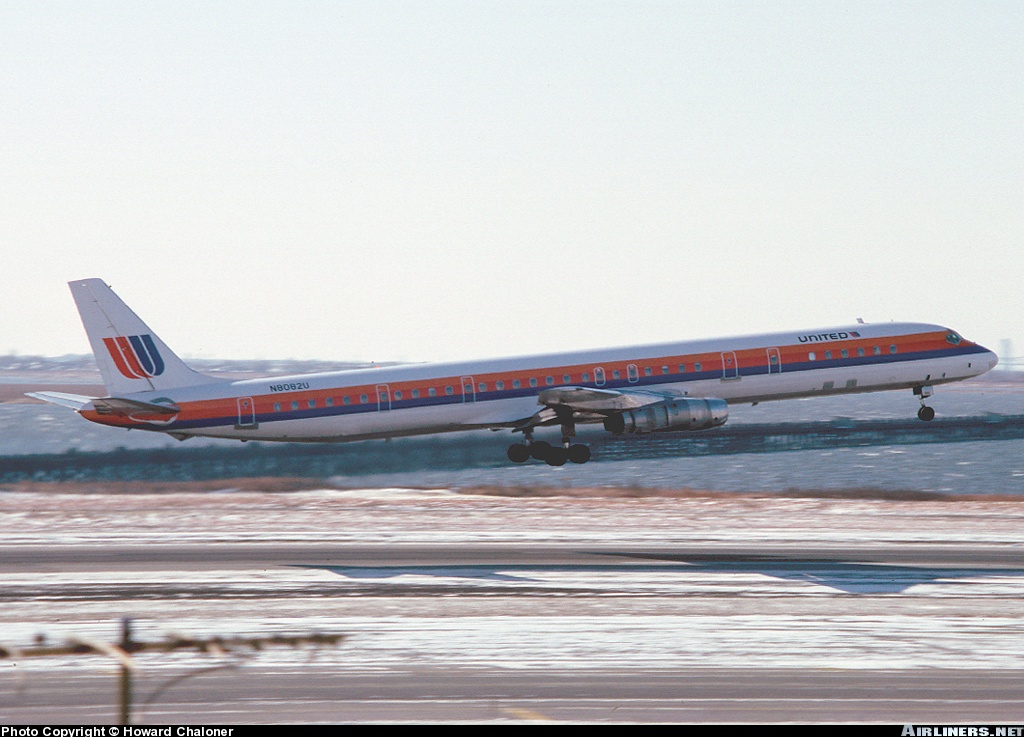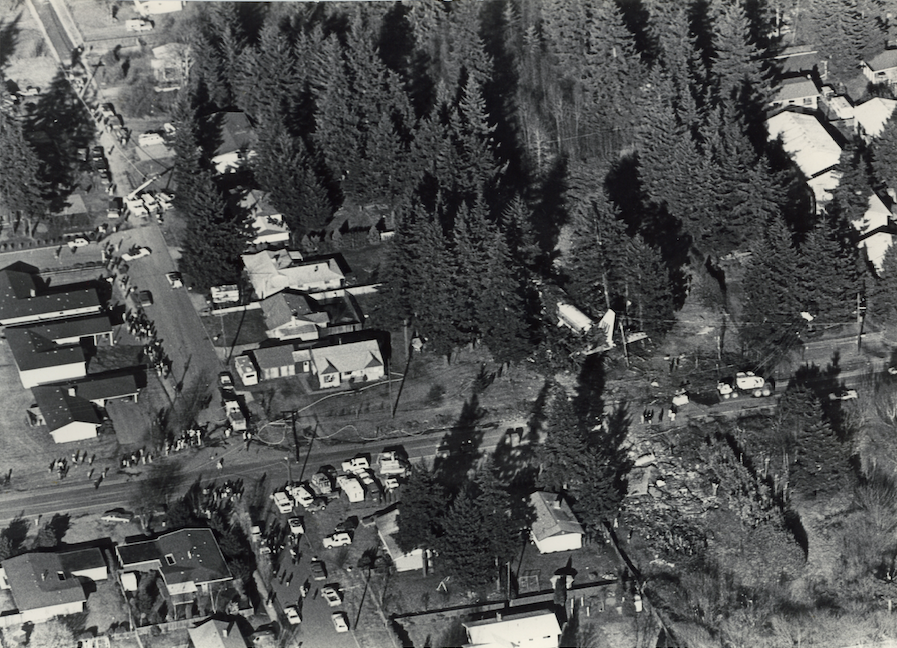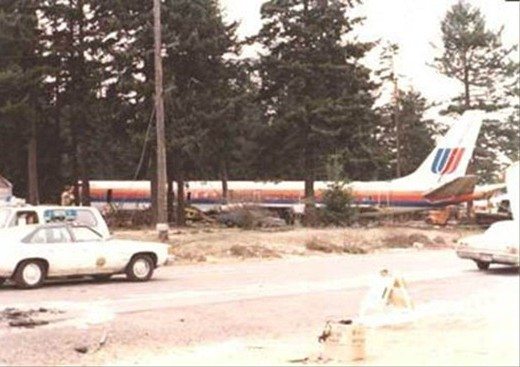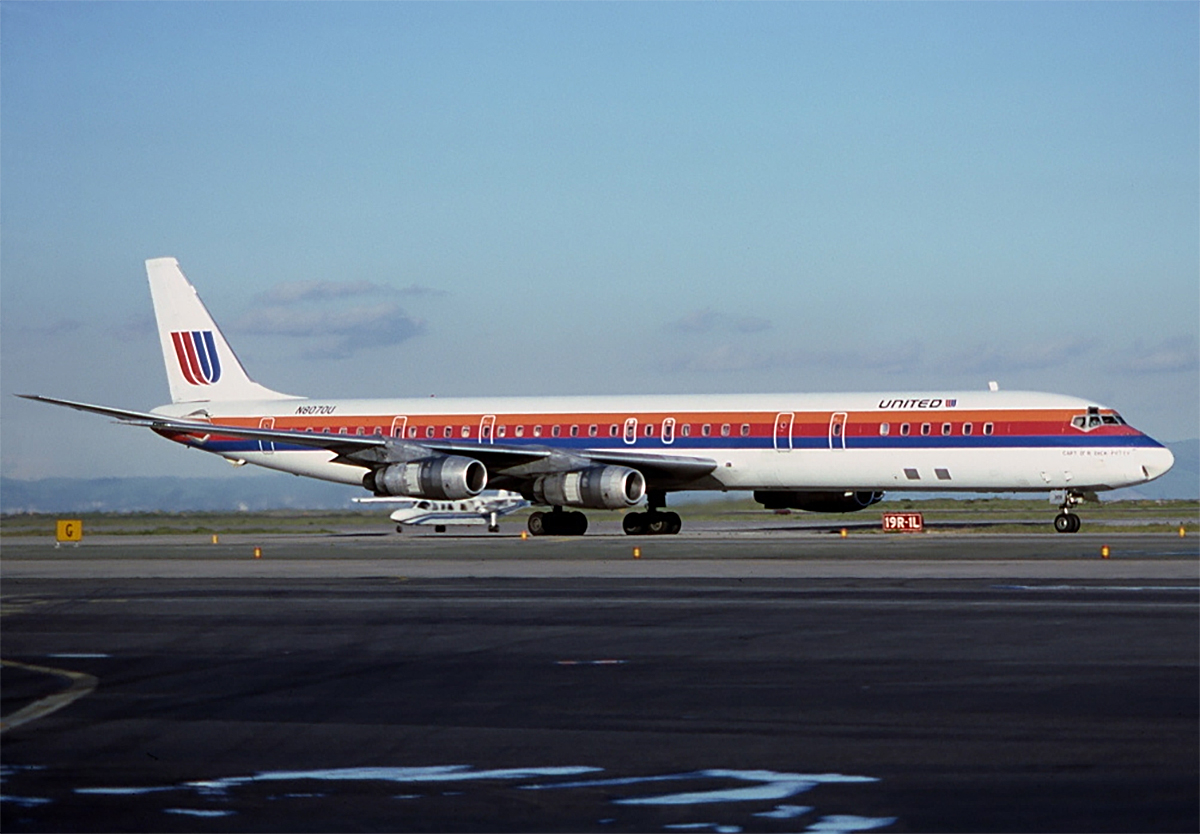
28 December 1978: United Airlines Flight 173, A McDonnell Douglas DC-8, N8082U, departed Stapleton International Airport (DEN), Denver, Colorado, enroute to Portland International Airport (PDX), Portland, Oregon. Under the command of Captain Malburn Adair McBroom, the airliner carried 181 passengers and 8 crew members. The planned duration of the flight was 2 hours, 26 minutes. The DC-8 carried 46,700 pounds (21,183 kilograms) of jet fuel, sufficient for the flight plus an additional 1 hour, 5 minutes fuel for the required 45-minute reserve and any contingencies.
On approach to Portland, the crew lowered the DC-8’s landing gear and flaps. They felt a heavy thump followed by a vibration and the airplane yawing. The indicator light showing that the main gear was down and locked did not illuminate.
Concerned that there was a problem with the landing gear, Captain McBroom aborted the landing and put the airliner in a holding pattern south of the airport. For approximately one hour, Captain McBroom, First Officer Roderick Duane Beebe, and Flight Engineer Forrest Ervin Mendenhall attempted to determine the nature of the problem. Finally, though the situation was not resolved, the crew turned toward Portland and prepared for an emergency landing.
At 18:06:46, the flight engineer reported, “We’re going to lose an engine,” and three seconds later, said, “We’re losing an engine.” The captain asked “Why?” The first officer responded, “Fuel.” The captain again asked “Why?”
At 18:07:06, Flight Engineer Mendenhall reported that the engine had “flamed out” (stopped running due to fuel exhaustion). Captain McBroom called Portland Approach Control and requested an immediate clearance to land at PDX, “now.” The airliner was then 18 miles south of the airport. McBroom asked Mendenhall to reset the landing gear circuit breakers. “See if we get gear lights.”
At 18:13:21, Mendenhall said, “We just lost two engines, guys.” Four seconds later, he said, “We just lost two engines—one and two.” [Both engines on the left wing.] McBroom said, “They’re all going,” and told First Officer Beebe to declare an emergency.
At 18:13:50, Beebe called, “Portland Tower, United One-Seventy-Three Heavy, mayday. We’re—The engines are flaming out. We’re going down. We’re not able to make the airport.” There were no further transmissions.
At approximately 18:15, United Flight 173 crashed in a residential area, about 6 nautical miles (11 kilometers) southeast of Portland International Airport. Eight passengers were killed, along with Flight Engineer Mendenhall and Senior Flight Attendant Joan Newton Wheeler. Another 23 persons were seriously injured. Two unoccupied homes were destroyed.

The National Transportation Safety Board (NTSB) investigation found:
3.2 Probable Cause
The National Transportation Safety Board determined that the probable cause of the accident was the failure of the captain to monitor properly the aircraft’s fuel state and to properly respond to the low fuel state and the crew-members’ advisories regarding fuel state. This resulted in fuel exhaustion to all engines. His inattention resulted from preoccupation with a landing gear malfunction and preparations for a landing emergency.
Contributing to the accident was the failure of the other two flight crewmembers either to fully comprehend the criticality of the fuel state or to successfully communicate their concern to the captain.
—NATIONAL TRANSPORTATION SAFETY BOARD AIRCRAFT ACCIDENT REPORT NTSB-AAR-79-7 , 7 June 1979, at Page 29

When the landing gear was lowered, a gear retraction cylinder failed, allowing the right main gear to fall into place. It locked, but a microswitch which should have activated the landing gear indicator light was damaged.
United Airlines’ operations manual required that the crew have the control tower make a visual check that the gear was down. Though it could not confirm that the gear was locked, if the visual check indicaated that landing gear appeared to be down, a landing was authorized. Captain McBroom deviated from this procedure.
The airliner was a McDonnell Douglas DC-8-61, serial number 45972, which had been delivered to United Airlines on 22 May 1968. At the time of the accident, it had flown a total of 33,114:33 hours.

The DC-8-61 is a four-engine turbojet-powered airliner with swept wings. It was a “stretched” variant of the basic DC-8 design, capable of carrying a maximum of 259 passengers. A 240 inch (6.096 meters) “plug” was installed forward of the wings and a 200 inch (5.08 meters) plug aft. This gave the airliner a total length of 187.4 feet (57.12 meters), with a wingspan of 142.4 feet (43.40 meters) and maximum height of 43 feet, 5.2 inches (13.239 meters). N8082 had a zero fuel weight of 201,927 pounds (91,592.6 kilograms), and a maximum certified takeoff weight (MTOW) of 325,000 pounds (147,418 kilograms). The maximum usable fuel was 23,393 U.S. gallons (88,552 liters).
The DC-8-61 was powered by four Pratt & Whitney Turbo Wasp JT3D-3B engines. This engine was a civil variant of the military TF33 series. The JT3D-7 was a two-spool axial-flow turbojet engine with a 2-stage fan, 14-stage compressor (7 intermediate-, 7 high-pressure stages) and 4-stage turbine (1 high- and 3 low-pressure stages). The JT3D-3B had a maximum power rating of 18,000 pounds of thrust. The engine was 145.5 inches (3.696 meters) long, 53 inches (1.346 meters) in diameter, and weighed 4,340 pounds (1,969 kilograms).
The DC-8-61 had a cruise speed of 0.82 Mach, and a maximum range of 3,200 nautical miles (5,926 kilometers). During a test flight at Edwards Air Force Base, 21 August 1961, a Douglas DC-8-43, N9604Z, reached Mach 1.1012.
© 2020, Bryan R. Swopes
This could have been prevented with a quick check of the view ports in the cabin floor to show the gear was down and locked.
And by Rule # 1 for handling in-flight emergencies: FLY THE AIRPLANE.
Bryan, you wrapped it up period, end of story. Seems sad that this crew screwed around like this till they burned her dry. What were they thinking, I mean not thinking.
Aviate, navigate, communicate.
I am a retired ARFF Captain. When I was a rookie I attended basic ARFF in Cincinnati. One of the best presentations was from a pilot who explained what happened in the cockpit during an inflight emergency. We would get frustrated on the ground due to a lack of information. When he said we aviate, navigate and communicate I realized they had a lot more going down than I’d imagined. Stuck with me my entire career. It was my understanding that the less information we got the busier they were.
Didn’t Eastern dump an airplane in the Everglades because the cockpit crew wasn’t paying attention to flying the airplane ?
Yes. See “This Day in Aviation” for 29 December 1972.
Captain McBroom was later exonerated.
United covered their asses by allowing the debris to be removed 4 days after the event and the NTSB failed in their investigation for allowing it.
Because of a history of retraction cylinders failing Capt. Mc Broom was concerned the right gear would fail upon landing causing the airplane to veer off the runway and into buildings with a great loss of life. He knew the maintenance history of that particular aircraft.
When he finally decided to land it was too late. The FE should have been more forceful but that was before CRM.
United put dollars before safety.
We’ll never know the absolute truth because the NTSB failed to secure the wreckage for proper examination.
That and because of the failure of the Oregon legal system the truth was never completely brought to light.
We reviewed this accident in a professional CRM course. Yes, the Captain was concerned about the gear failure upon landing. But what drove the fuel starvation was his concern for a fire after the landing if the gear failed. He was fixated on a previous accident he knew about that had a substantial fire after a gear failure on landing, so he wanted to reduce the fuel load as much as possible. He over corrected and refused to listen to his crew who were in fact very vocal about the low fuel state. But those were the days when the captain was absolute king and didn’t really pay much attention to his crew. Such a shame. CRM has changed much of that now.
Yes, however…
Not to let the Captain off the hook but the engineer is the one staring at the fuel gauges and should have been way more vocal about running out of gas. Also, planned landing with just 1:05 worth of fuel? No time for trouble shooting anything!
If I remember correctly they only built 6 of these stretch DC8s to transport troops to and from Viet Nam. I flew on 1 from Okinawa to Oakland (maybe SF) returning from Viet Nam. I flew on one on a charter from Detroit to Las Vegas sometime in the late 70s early 80s. Neither plane was operated by a major airline. Both were six seats across for the full length of the cabin. I believe the DC8 that crashed in Gander was also one of the stretch bodies.
I flew on a stretch DC8, operated by Flying Tigers, May 1979. Travis AFB to Okinawa. Fuel stops in AK and Yokohama. It took every bit of usable runway to get it off the ground. My window seat gave me a good vantage point. I was counting the strips on the runway. I ran out of strips as the plane slowly climbed, afterward I saw grass right away.
Not only was this crash in the days before CRM, it was the accident that gave birth to CRM (Began life as CLR at United). The flight engineer did note the low fuel quantities multiple times, and did attempt to bring it to the attention of the captain. But, this was the age where the captain was truly running the show, and input from other cockpit and cabin crew members was often disregarded. Working as a team is not a natural skill, and must be taught. After this accident, it was finally taught.
I’m impressed at how intact the plane is after smashing through a couple of houses and into a wooded area.
I didn’t remember the details of this incident. I was surprised at 1) how intact the aircraft was, and 2) how low the body count was. I was expecting major carnage after an airliner dead-sticks into a suburban development. I guess the zero-fuel situation mitigated against explosion or fire.
Not familiar with viewing ports for gear on DC-8-61. B-727, yes, DC-9 nosewheel,yes, but not DC-8. I was an S/O on the 8, but it was many moons ago and my memory could be wrong.